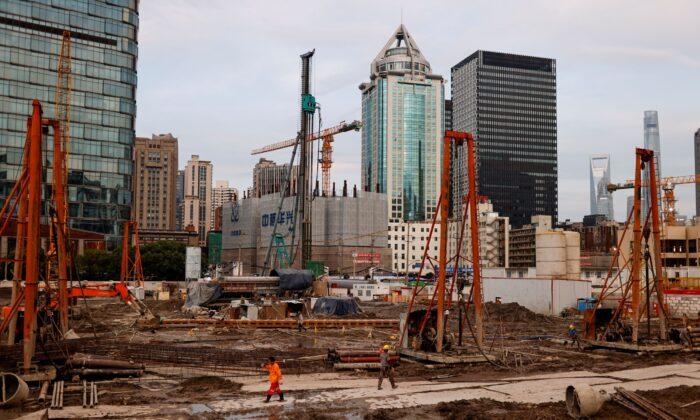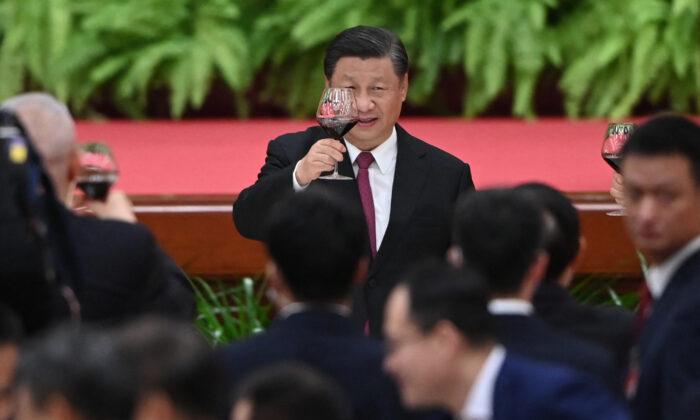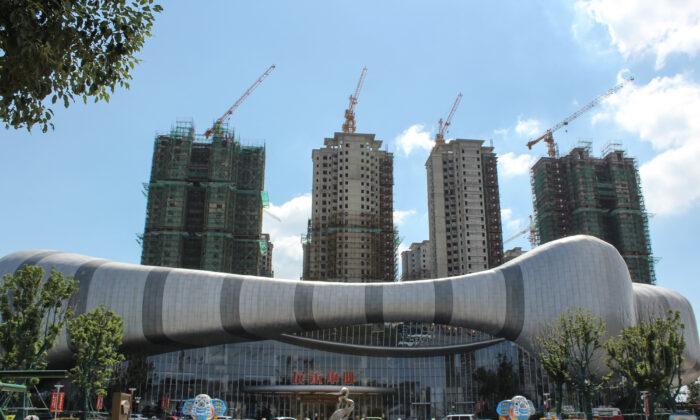The Chinese Communist Party (CCP) has been vaunting “self-reliance” since its relationship with the United States took a sharp turn for the worse. However, with dwindling exportation prospects, the CCP must depend on its foreign exchange reserves to continue to import vital goods including petrol, food, and semiconductor chips.
The true level of China’s foreign exchange reserves remains a mystery, but a recent article posted on the Chinese internet titled “How Many Foreign Exchange Reserves Are Left?” warns about the deficiency.
Understanding Foreign Exchange Reserves
A country’s foreign exchange reserves are just like a family’s financial assets. A family’s net financial assets equal the total amount in the books minus loans it borrowed and any bad debts that can’t be collected. When a family’s income is greater than its spending, its net assets will grow. When the opposite happens, its net assets decline.Similarly, a country’s net foreign exchange reserves, or disposable foreign exchange, equal its total reserves minus its debts and loans to other countries that can’t be claimed. When its foreign exchange spending is greater than its income, the country will need to fill the gap with its net foreign exchange reserves. Each year, China imports large amounts of petrol, food, chips, and other manufactured parts to maintain its operations. In 2019, China spent $588.8 billion on importing food, petrol, and chips alone. In addition, China spends more than $100 billion annually on non-trade expenditures such as civil aviation, shipping, international insurance, and the foreign currency needed by overseas travelers.
China’s daily foreign exchange income relies on exports, especially surplus to the United States. Between 2000 and 2010, China’s exportation remained at a record-high 25 percent annual growth rate, and foreign exchange flooded into the CCP’s pockets.
But in 2020, exportation only grew 2 percent from January to September, while the expenses continued to pile up. In the past, the annual $300 billion to $400 billion annual surplus to the United States formed the majority of China’s foreign exchange income. With exports to the United States declining, China’s income source is now at high risk. Without the surplus, the CCP will have to use its foreign exchange reserves to cover its spending. This will force the CCP to tighten up its control over the reserves, which explains the recent difficulty of exchanging and withdrawing foreign currency from small and medium Chinese banks.

The Truth About China’s Foreign Exchange Reserves
At the end of September, the CCP held $3.1 trillion in foreign exchange reserves. This may sound very impressive, but it’s worth noting that these don’t equal disposable cash. This is because China also carries a $2 trillion outstanding foreign exchange debt, about 60 percent of which comprises one- to two-year short-term debts that must be repaid by the due date. In addition, 66 percent of the debts are hard currency debts that must be paid with foreign currency. This means the CCP’s net foreign exchange reserves is only $1.8 trillion after deducting the debts.Low Cash Reserves
Most of China’s disposable foreign exchange reserves isn’t cash. The reserves can’t be deposited in Chinese banks, because once a foreign currency is devalued, the deposited reserves will immediately suffer losses. Neither can the reserves be saved in foreign banks, because foreign banks have limited deposit insurance, and once a bank goes bankrupt, the reserves will sink along with it. The reserves can’t be used to purchase high amounts of foreign stocks or corporate bonds, because the volatility of the stock market will bring too much risk.The best way to reserve the value of the foreign exchange reserves is for a country’s central bank to buy reliable foreign national debts that offer higher interest than bank deposits. This will sustain or slightly increase the value of the reserves. A foreign debt is considered reliable when this country has high credibility, a low risk of the government going bankrupt, and timely payment. Though China is in a cold war with the United States, it still has to purchase large amounts of American debts because the United States issues large amounts and reliable debts. Other credible countries such as Japan and European countries don’t have enough debts for the CCP to purchase.
By Aug. 1, China holds $1.068 trillion worth of U.S. debts, which accounts for two-thirds of its net foreign exchange reserves. In addition, China also holds small amounts of Japanese yen and Euro debt.
There has been a lot of talk in Chinese media and social media platforms about China being able to weaponize the $1 trillion in U.S. debts and corner the United States by selling off the debts. This is a ridiculous idea not based on financial common sense. The United States has issued $26 trillion national debts, of which China holds only 3.8 percent. Even if China sells off the debts, it won’t have a major impact. Additionally, most of the U.S. debts that China purchased were mid- and long-term debts with higher interest. Because the debts won’t be repaid until the due date, the only way China could sell off the undue debts would be to sell at prices lower than the purchase price and hope someone would buy. In this case, China would suffer huge losses.
Overseas Investments Dried Up Cash Reserves
Even this $500 billion has actually been mostly spent. In the past year, the CCP has extravagantly invested $2.2 trillion overseas. How can this be possible given the $500 billion in cash reserves? This is because most of the overseas investments were paid with Chinese currency (yuan).China doesn’t publish the ratio of yuan investments in its overseas investments, but we can find some clues from published information. According to the Chinese Department of Commerce’s 2019 Chinese Foreign Investment Development Report, by the end of 2018, China had invested $46.1 billion in Africa, $98.6 billion in Belt and Road Initiative countries, and $1.1 trillion in Hong Kong. These three components accounted for 43 percent of China’s total overseas investments. Since the majority of these investments were made in yuan, and some of the investments in other countries were also made in yuan, only a relatively small part of the CCP’s overseas investments is sourced from the foreign exchange reserves. However, even a small part of the mammoth investment is enough to dry up its very limited foreign exchange reserves.
When the foreign exchange reserves are running out, can the CCP pull back the investments and turn them into foreign exchange? By the end of 2018, 78 percent of the CCP’s foreign investments were in rental and commercial services, finance, wholesale and retail, telecom software and IT services, real estate, transportation, and warehouse businesses. Rental and commercial services mainly involve the rental of equipment that most people are unwilling to purchase, so it would be hard to sell off the equipment.
In the past decade, China also invested in mining and natural resources, but it would be difficult to sell the mines since no other country consumes more mineral resources than China. The wholesale and retail businesses have been impacted greatly by the pandemic, so it would be very difficult to sell these businesses at this time. The service industry is facing this challenge: The AMC movie theater chain, acquired by Chinese real estate tycoon Wang Jianlin, is on the brink of bankruptcy due to the pandemic.

$3 Trillion Is Just an ‘Empty Number’
It’s hard to understand or believe that with a nominal $3 trillion in foreign exchange reserves, the CCP actually has very little in cash reserves. The above analyses show that the CCP senior leaders’ overconfidence in the domestic economy, overestimation of their ability to manipulate international matters, and strong ambition to control the world have led the CCP to invest in overseas markets more than its foreign exchange reserves can afford.The CCP had to sell some U.S. debts to acquire foreign currency to sustain importation.
According to Chinese media, China sold $107 billion U.S. debt in the first seven months of 2020. It is estimated that another $200 billion will be sold in the future, reducing China’s U.S. debts to $800 billion. Only 3 percent of China’s U.S. debts are short-term debts, but the debts that already have been sold and are expected to be sold account for 30 percent of China’s total U.S. debts. This means China has started selling short- and mid-term debts to get through the foreign exchange shortage. Moving forward, China will have to sell its long-term U.S. debts at a discount to meet its cash needs.
The minimum safe level of a country’s foreign exchange reserves needs to cover near-term debt payments and three months’ worth of importation costs. For China, this means at least $200 billion. The recently sold $100 billion and the upcoming sales of $200 billion in U.S. debts will help to keep the reserves at the minimum level. Meanwhile, the CCP has recently increased the issuance of China’s national debts to bring in more foreign exchange for urgent needs. This is just a band-aid solution, and it won’t take long for the CCP to fall into a vicious cycle of paying old debts with new ones.
How much foreign exchange can China’s trade surplus bring? China’s export to the United States was $320 billion in the first three quarters of 2020, a 1.8 percent increase from the same time last year. Imports from the United States during the same time totaled $96.1 billion, a 2.8 percent increase from last year. This translates to a $230.9 billion surplus. If President Donald Trump gets reelected, it’s very likely that he will continue to raise import tariffs on China to reduce the trade surplus. In that case, the CCP will feel even more pressure.
The $100 billion from the sale of the U.S. debts and the $40 billion from national debts issued between April and September will all be used to cover necessary foreign exchange spending, so it won’t help the CCP with stabilizing its foreign exchange reserves. At the end of September, China’s total foreign exchange reserves dropped $22 billion to $3.1426 trillion, from the previous month’s $3.1646 trillion. The CCP’s nominal $3 trillion in foreign exchange reserves is just an empty number on paper. Soon, its foreign exchange shortage will be fully exposed to even untrained eyes.





